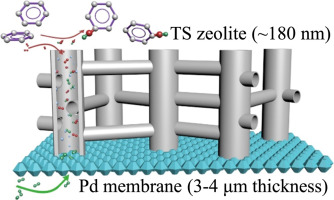当前位置:
X-MOL 学术
›
J. Membr. Sci.
›
论文详情
Our official English website, www.x-mol.net, welcomes your feedback! (Note: you will need to create a separate account there.)
Catalytic palladium membrane reactors for one-step benzene hydroxylation to phenol
Journal of Membrane Science ( IF 9.5 ) Pub Date : 2018-10-01 , DOI: 10.1016/j.memsci.2018.06.058 Xiaobin Wang , Yiming Zou , Bo Meng , Xiaoyao Tan , Shaobin Wang , Shaomin Liu
Journal of Membrane Science ( IF 9.5 ) Pub Date : 2018-10-01 , DOI: 10.1016/j.memsci.2018.06.058 Xiaobin Wang , Yiming Zou , Bo Meng , Xiaoyao Tan , Shaobin Wang , Shaomin Liu

|
Abstract Pd membranes can be applied to many hydrogenation or dehydrogenation reactions for chemical production. Such membrane reactors can realize the simultaneous separation and reaction in one unit. However, the Pd membrane is easily poisoned by hydrocarbons or other impurities at high temperatures and itself does not provide sufficient catalytic efficiency. To overcome these problems, here we report a novel bifunctional titanium silicalite (TS) zeolite modified Pd capillary membrane microreactor for one-step hydroxylation of benzene to phenol. Using the state of art technology to uniformly anchor the monolayer of TS nanoparticles on the Pd membrane is still a challenge. In this work, the TS nanoparticles were attached the Pd membrane surface via a novel and efficient covalently bonding method using alkoxysilane linkers. The effects of various Pd membranes with different TS zeolite loading on the reaction efficiency and long-term stability were investigated. The benzene conversion and phenol yield could be dramatically increased by applying the TS nanoparticles as the catalyst compared to the blank Pd membranes. A maximum benzene conversion of 23.4% and phenol yield of 22.3% were achieved at 473 K and 100 kPa, much higher than that typically reported in Science (Niwa et al., 2002) with the benzene conversion and phenol yield of 13.3% and 11.3%, respectively. The TS zeolite modified Pd membranes also displayed good stability for low temperature separation and reaction during 110-h long-term-test at 473 K and 100 kPa. The deposited uniform TS catalyst in a monolayer not only provides good catalytic properties to improve reaction efficiency but also works as the diffusion barrier to protect the Pd membrane by avoiding the direct contact of the hydrocarbon molecules and Pd surface. The possible reaction pathway for TS zeolite modified Pd membrane microreactor for the direct benzene conversion to phenol was also elucidated.
中文翻译:

苯一步羟基化制苯酚的催化钯膜反应器
摘要 Pd膜可应用于化工生产的多种加氢或脱氢反应。这种膜反应器可以在一个单元中实现同时分离和反应。然而,钯膜在高温下很容易被碳氢化合物或其他杂质中毒,并且本身不能提供足够的催化效率。为了克服这些问题,我们报告了一种新型双功能钛硅沸石 (TS) 沸石改性 Pd 毛细管膜微反应器,用于苯一步羟基化生成苯酚。使用最先进的技术将 TS 纳米粒子的单层均匀地固定在 Pd 膜上仍然是一个挑战。在这项工作中,TS 纳米粒子通过使用烷氧基硅烷接头的新型有效共价键合方法附着在 Pd 膜表面。研究了具有不同TS沸石负载量的各种Pd膜对反应效率和长期稳定性的影响。与空白 Pd 膜相比,使用 TS 纳米颗粒作为催化剂可以显着提高苯转化率和苯酚产率。在 473 K 和 100 kPa 下实现了 23.4% 的最大苯转化率和 22.3% 的苯酚产率,远高于 Science(Niwa 等人,2002 年)报道的苯转化率和苯酚产率分别为 13.3% 和 11.3% %, 分别。TS 沸石改性 Pd 膜在 473 K 和 100 kPa 的 110 小时长期测试中也显示出良好的低温分离和反应稳定性。在单层中沉积的均匀 TS 催化剂不仅提供了良好的催化性能以提高反应效率,而且通过避免烃分子和 Pd 表面的直接接触,还可以作为扩散屏障来保护 Pd 膜。还阐明了 TS 沸石改性 Pd 膜微反应器将苯直接转化为苯酚的可能反应途径。
更新日期:2018-10-01
中文翻译:

苯一步羟基化制苯酚的催化钯膜反应器
摘要 Pd膜可应用于化工生产的多种加氢或脱氢反应。这种膜反应器可以在一个单元中实现同时分离和反应。然而,钯膜在高温下很容易被碳氢化合物或其他杂质中毒,并且本身不能提供足够的催化效率。为了克服这些问题,我们报告了一种新型双功能钛硅沸石 (TS) 沸石改性 Pd 毛细管膜微反应器,用于苯一步羟基化生成苯酚。使用最先进的技术将 TS 纳米粒子的单层均匀地固定在 Pd 膜上仍然是一个挑战。在这项工作中,TS 纳米粒子通过使用烷氧基硅烷接头的新型有效共价键合方法附着在 Pd 膜表面。研究了具有不同TS沸石负载量的各种Pd膜对反应效率和长期稳定性的影响。与空白 Pd 膜相比,使用 TS 纳米颗粒作为催化剂可以显着提高苯转化率和苯酚产率。在 473 K 和 100 kPa 下实现了 23.4% 的最大苯转化率和 22.3% 的苯酚产率,远高于 Science(Niwa 等人,2002 年)报道的苯转化率和苯酚产率分别为 13.3% 和 11.3% %, 分别。TS 沸石改性 Pd 膜在 473 K 和 100 kPa 的 110 小时长期测试中也显示出良好的低温分离和反应稳定性。在单层中沉积的均匀 TS 催化剂不仅提供了良好的催化性能以提高反应效率,而且通过避免烃分子和 Pd 表面的直接接触,还可以作为扩散屏障来保护 Pd 膜。还阐明了 TS 沸石改性 Pd 膜微反应器将苯直接转化为苯酚的可能反应途径。


























 京公网安备 11010802027423号
京公网安备 11010802027423号